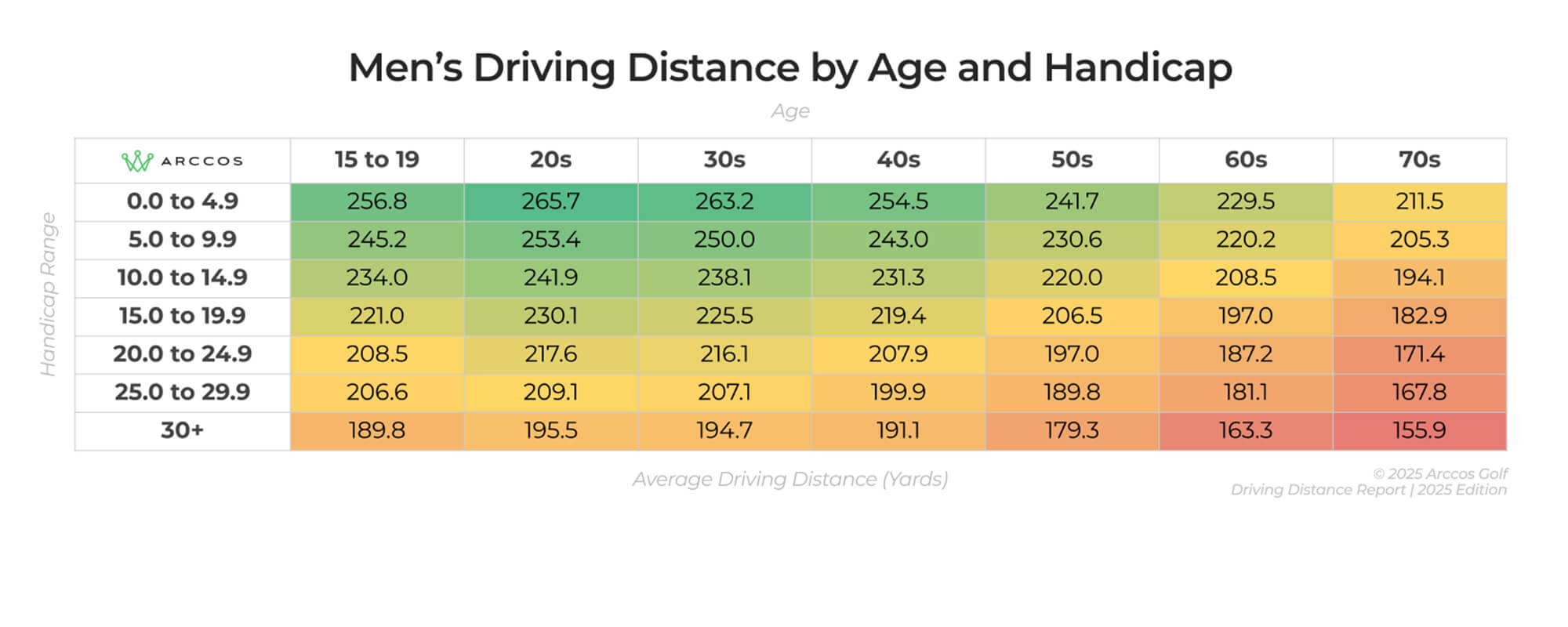Golfing News & Blog Articles
6 Insights from the Arccos Driver Distance Report
Every year, the debate around distance in golf heats up, fueled by governing bodies, pro tours, and pundits convinced that golfers are hitting the ball too far.
It’s gotta be the ball (or some such nonsense).
Data collected by Arccos tells a different story.
About the Arccos annual driving distance report
Now in its seventh year, the just-released annual Arccos Driving Distance Report draws from more than 6.5 million driver shots captured across 4 million rounds played in 2024. This year’s report offers the most detailed look yet at how real golfers perform off the tee. The findings? They cut straight through the noise, challenging assumptions, exposing trends, and reminding us that distance isn’t the villain some have made it out to be.
So with that said, let’s look at six key insights from the most recent report.
Average golfers aren’t hitting the ball too far

Over 7 years of Arccos distance insights, men’s average driving distance has been largely flat, ranging from just under 222 to 225 even.
For women, distance is also mostly flat, ranging from a low of just over 176 to just under 180.
This stagnation suggests that fears about distance increases at the recreational level are entirely unfounded. If anything, women have seen a slight decline.
Remind me again why we need to roll back the golf ball?
Oh, that’s right. We don’t.
Distance and handicap are closely correlated

Across all age groups, the lowest handicap golfers are, on average, the longest off the tee.
While we’ve all heard the adage, drive for show, putt for dough, the fact is that your tee shot sets the tone for the hole.
Longer drives mean shorter approach shots, which translates to more greens hit (and shorter putts when you do manage to hit the green).
Average distance decreases with age
While I suppose this isn’t particularly surprising, average driving distance decreases with age. Male golfers in their 20s are, on average, a bit longer than those in their teens, but it’s downhill from there.
As we move from decade to decade (30s-40s, 40s-50s, etc.), distance losses become increasingly significant. Again, this isn’t surprising, but I’m still unhappy about it.
For men in their 70s, the average driving distance is 211.5. For women in their 60s, the data suggest the average driving distance is likely less than 150 yards.
Accuracy increases with age

If there’s a silver lining that comes from diminished distance, I suppose it’s increased accuracy. Male golfers in their 20s hit the fewest fairways (42.9%), while golfers in their 70s hit 60%.
The math is pretty simple on this one. All things being otherwise equal, the shorter the ball travels, the more likely it is to stay in the fairway. For what it’s worth, the biggest jump in accuracy occurs between 40 and 50, but I’m guessing that’s not universally true, as I’ve yet to experience it.
Low-Handicap golfers aren’t just longer, they’re straighter too

We often talk about distance vs. accuracy as if it’s a choice, and you only get to pick one. As it turns out, the best golfers are, on average, longer and straighter than less accomplished players.
Factoring all age groups, low-handicap golfers (0–4.9) average 250.0 yards and hit 49.3% of fairways, while high-handicap golfers (30+) average 184.9 yards and hit just 40.6% of fairways.
I’ll save you that math; that’s a 65.1-yard difference in distance coupled with an 8.7 percentage point advantage for the better player.
While not as severe, even average golfers (golfers with handicaps between 10 and 14.9) trail better players in both distance and accuracy. They average 224.7 yards and hit 45.3% of fairways.
This suggests that increased distance doesn’t mean diminished accuracy, especially when paired with skill.
High-Handicappers hit more “wayward” tee shots

It’s not just about fairways hit. Arccos looked at “wayward” drives—those leading to penalties or recovery shots—as well.
High-handicap players are significantly more likely to hit a tee shot that results in a punch-out, drop, or worse.
30+ handicap golfers hit 1 in 4 drives into some kind of trouble. That’s 1.5x the rate of the low handicap golfers.
Golfers in the 10-14.9 handicap range are over 50% more likely to hit their drive into a penalty area than low handicappers. They also hit nearly 1 in 5 tee shots into trouble areas. That’s roughly 30% more than low-handicap players.
Distance inarguably has value, but there’s something to be said for painting between the lines and staying out of trouble.
The Takeaway
While distance may dominate headlines, the Arccos report shows that skill, not power (although they often go hand-in-hand), is the true differentiator. Low-handicap golfers aren’t just longer; they’re straighter and smarter with their misses. Meanwhile, the average recreational player isn’t gaining yardage; they’re just trying to stay in play.
For those interested in diving deeper, the full report breaks down performance by age, gender, and handicap with enough insight to keep both data nerds and golf nerds satisfied. You can explore the full Arccos 2025 Driving Distance Report here.
The post 6 Insights from the Arccos Driver Distance Report appeared first on MyGolfSpy.


